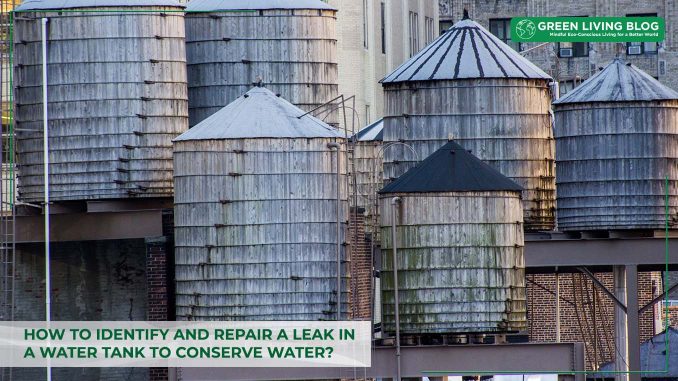
Water conservation is essential, and the first step is identifying where we may be wasting water. An unnoticed water tank leakage can waste significant amounts of water. However, identifying and repairing the leak in your water tank can be simplified with a few steps.
Start by examining the area around your tank. Look for damp spots on the tank surface or a pool of water at the tank base. Such signs can be an indication of a leak. Also, observe your water usage pattern; a sudden increase can mean a leak.
If a leak is detected, don’t panic. The repair can often be done using sealants or patches easily available in the market. If you doubt the severity of the leak, consult a professional immediately at https://www.watertankfactory.com.au/ to avoid water wastage.
Remember, turbulent times don’t last. The sooner you detect and repair the leak, the sooner you’ll be conserving water. Be observant and proactive in identifying any possible leakages in your water tank and save water, life’s most precious resource.
1. How to Identify Water Tank Leaks

Spotting leaks in your water tank early can prevent higher water consumption, which ultimately results in an increased water bill. Even minor ignored leaks can lead to major issues over time. Hence, it becomes vital for every homeowner to vigilantly monitor their water tanks for potential leaks.
Detecting Moist Areas
Browse around the base of your water tank. If you find unusual moisture or pooling water, it may indicate a water leak. However, condensation can sometimes confuse you as it mimics leakage signs. Therefore, make sure the cause is a leak and not just humidity or heat changes.
Higher Water Bills
A sudden rise in your monthly water bills could be a red flag indicating a potential leak in your home’s water tank. Make sure to keep track of your monthly usage and bills regularly to detect any anomalies hinting at water wastage due to unnoticed leaks.
Listening for Dripping
Unseen leaks can often be heard before they become visible, particularly in quiet homes. Regularly take the time to listen closely around your water tank especially when there’s no use of water elsewhere in your home.
Saving With Repairs
The Environmental Protection Agency (EPA) estimates that fixing easily corrected household water leaks can save homeowners about 10% on their water bills. Thus, addressing even small leaks quickly and correctly can result in substantial savings across the board.
2. How to Determine the Leak Origin
To efficiently and effectively handle a water tank leak, the first step is understanding its source. They often originate from areas on the tank that are vulnerable to corrosion or stress.
An important aspect in identifying the leak’s origin is careful observation. Look for areas with visible moisture or discoloration, indicating potential spots where water seepage may occur.
- Inspect joints and seams: Often, they’re susceptible to leaks due to constant pressure and potential weak areas in their design.
- Check system valves: Any defective or loosely fitted valves can cause water leakage frequently.
- Survey the tank base: Corrosion or rust usually appears over time at the bottom of your tank which can lead to tiny perforations.
Your investigation must be thorough as any negligence can lead to serious consequences. A startling fact illustrates this point: A pinhole leak in a tank can escalate to a burst or a catastrophic failure within a matter of hours if not detected and repaired in time.
Adequate understanding of the leak’s origin allows you to determine the best repair method – either DIY fixes or professional intervention. This decision depends primarily on the severity and nature of the leak.
3. How to Repair a Leaky Valve

Water tank leaks often occur at the valve, usually due to worn-out parts. Fortunately, you can easily repair this with the right tools and steps.
Your first step is to identify the source of the leak. Look closely at the valve, particularly where it attaches to the tank. Check if water drips from the valve when it’s in both open and closed positions.
- Shut Off the Water Supply: It is critical to shut off your water supply before carrying out any repair work.
- Gather Necessary Tools: You will require a pipe wrench, plumber’s tape and replacement valve if needed.
- Remove the Leaky Valve: Using your pipe wrench, twist and unfasten the faulty valve from the tank.
- Apply Plumber’s Tape: Wrap this around the threads of your replacement valve for a tighter and secure fit.
Once you have successfully removed the old valve, replace it with a new one. Ensure all connections are properly tightened. Turn on your water supply and observe if there are still any visible leaks.
Note that dealing with larger water tank models or more complex leak issues may require professional attention. However, these steps should effectively handle minor leaks in your home water tank’s valves.
4. How to Fix Corroded Pipe Fittings
Often, water tank leaks are caused by corroded pipe fittings. Regular inspection can identify this issue early on, minimizing the waste of water. It’s alarming to note that small leaks can result in about 22 gallons of water wastage daily.
If you detect signs of corrosion like rust spots or discolored water, immediate action is crucial. Essential repair tools for this task include a pipe cutter, new fittings, and plumber’s tape to ensure a snug connection.
“;;
| Type of tools | Usage |
| Pipe Cutter | To neatly cut off the corroded part of the pipe. |
| New Fittings | To replace the corroded ones and maintain efficiency. |
| Plumber’s Tape | To secure the connection and prevent future leaks. |
| Note: Tools to fix corroded pipe fittings on a water tank. | |
The first step is to remove the corrupted section using a pipe cutter. Next, fix the new fittings at each end of the cut pipe securely. Wrap the plumber’s tape around these connections to create a waterproof seal and prevent additional leaks.
Be sure to test your repair work before use by letting water flow through it while watching carefully for any leakage. If no water escapes, you have successfully stopped your tank leak which will conserve hundreds of gallons in larger leaks.
How to Address Expansion Tank Leakage

Your water tank leakage might be related to the expansion of the tank. The expansion tank works alongside your water heater to absorb excess pressure. A leak in this component can significantly contribute to water waste.
Inspect the Expansion Tank
The first step would be to examine for any visible damage. Discoloration, rust, or physical damage on the expansion tank are all possible signs of a leak.
Testing the Tank
You can then test pressure to ensure its functionality. Use a tire pressure gauge to test; the readings should match your water tank’s psi reading.
Pressure Adjustment
If not, it implies internal bladder failure. You’ll need to adjust the pressure manually using an air compressor, but this is usually a temporary solution.
Professional Assistance
For lasting repair of your leaking water tank, it’s best to seek help from professionals that can diagnose and address complex issues beyond a DIY repair. They are equipped with specialized tools and knowledge that guarantee both safety and durability in repairs.
How to Prevent Future Tank Leaks
The first line of defense in preventing tank leaks is developing good maintenance habits. Regular inspections and care can significantly reduce the risk of surprising water leakage.
Preventative maintenance and regular inspections play a pivotal role in conserving your water. This approach helps spot potential problems before they escalate. According to research, this strategy can decrease leak probabilities by as much as 50%.
- Regular Inspections: Always keep an eye on the condition of your tank. Look for signs of rust, bulges, or other abnormal conditions.
- Prompt Repairs: If you notice a small leak or another issue, don’t delay repairs. Prompt action can prevent a small problem from becoming a major, costly failure.
- Professional Servicing: Consider hiring professionals for annual servicing. They can properly inspect and tune up your system to prevent future leaks.
Making these habits part of your routine will extend the lifespan of your water tank while conserving precious resources. Remember, a little preventative care goes a long way in keeping your system running smoothly.
In addition to preventive servicing, investing in high-quality water tanks and fittings can greatly aid in avoiding leaks. Good quality equipment is designed to withstand pressure changes and environmental conditions which potentially lead to leaks.
How to Conserve Water with Maintenance

Conserving water takes more than simple rationing during everyday usage. Taking care of your water systems, like regularly inspecting and maintaining your water tank, is crucially important.
Consider the fact that a mere 1/8-inch hole in a metal water tank can result in a loss of 2,500 gallons of water in 24 hours at 40 psi pressure. This is a significant amount of wasted water and an avoidable expense with proper maintenance.
- Regular Inspections: The first step towards conserving water through maintenance involves regular inspections. Check for common signs of leakage such as wet spots, corrosion or rust.
- Routine Cleanings: Routinely cleaning your tank prevents the build-up of minerals and sediment. This prolongs the life of the tank while preventing leaks.
- Safe Adjustments: Unless you’re specifically trained, it’s best to avoid adjusting the pressure settings on the tank yourself. Unwise changes could cause leaks or other damage.
By committing to these proactive water management steps, you protect your investment and conserve vital resources simultaneously. Your commitment to conservation doesn’t just help you; it aids in global water preservation efforts.
![]()
Author Profile
- Passionate content creator, contributor, freelance writer and content marketing allrounder.
Latest entries
 Green LivingApril 17, 20254 Eco-Friendly Habits to Pair With Your Herbal Tea Ritual
Green LivingApril 17, 20254 Eco-Friendly Habits to Pair With Your Herbal Tea Ritual Best practicesApril 12, 2025Top 6 Eco-Friendly Choices for Sustainable Living in Your Everyday Life
Best practicesApril 12, 2025Top 6 Eco-Friendly Choices for Sustainable Living in Your Everyday Life BusinessMarch 31, 2025How to furnish your Office with sustainable Cardboard Furniture
BusinessMarch 31, 2025How to furnish your Office with sustainable Cardboard Furniture Best practicesMarch 21, 202511 Practical Ways to Limit Your Exposure to Microplastic Pollution
Best practicesMarch 21, 202511 Practical Ways to Limit Your Exposure to Microplastic Pollution






Leave a Reply
You must be logged in to post a comment.